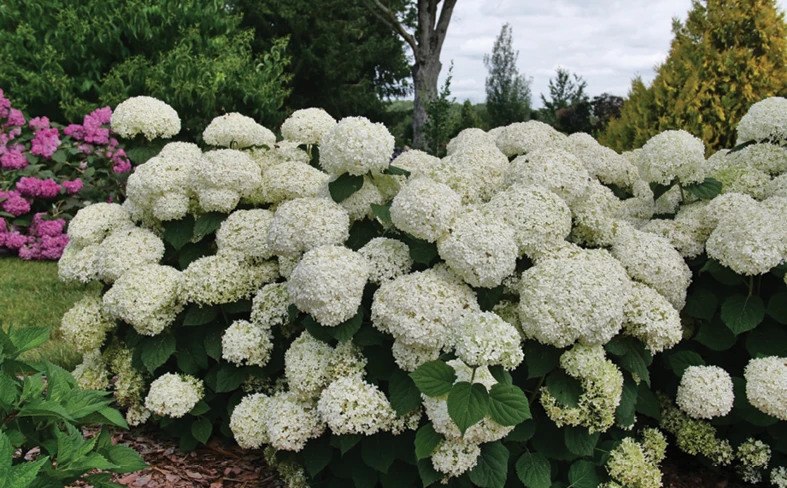|
To help increase water efficiency, nursery owners and managers — particularly those in more drought-prone regions — are turning to non-potable water as an alternative to fresh water for irrigation. In many cases, that non-potable water is recycled rainwater or run-off that’s being harvested on-site through the use of vegetative buffers, swales and cisterns. Nurseries that recycle their own water have far greater control over the containment of potential pollutants that could have adverse affects on crops. Recycling water is one way nurseries can become more sustainable — something that consumers are certainly looking for in almost every product they purchase. Close monitoring required “Recycled water often has a different chemical nature than the normal supply for any given nursery,” Hulme said. “That makes it necessary to closely monitor water and growing media for an accumulation of nutrients or negative ions such as sodium or chlorides, and make any necessary adjustments to fertilizer programs. If nutrient levels are consistently high, the fertilizer rates should be reduced accordingly. If there are potentially high levels of negative ions, filters might have to be installed, or recycled water might have to be blended with fresh water to bring these levels down to acceptable levels.” Greenleaf Nursery in Park Hill, Okla. has successfully used recycled water for years. Located about 60 miles southeast of Tulsa, Greenleaf specializes in woody ornamentals — primarily shrubs and trees — but also grows many perennials and a few annuals. The nursery first turned to the idea of recycled water in 1991, said Ken Polak, Greenleaf’s plant culture coordinator. “Greenleaf’s owners felt that this type of water recycling system would eventually be mandated, and rather than incur the total expense all at once, they first started using recycled water on just one-fifth of the nursery,” Polak said. Be proactive “We average about 40 inches of rain per year, so the decision to recycle our water wasn’t based upon a concern about depleting resources,” Polak said. “It was more about protecting the resources we have.” When the Oklahoma summers become hot and dry, Greenleaf uses a special permit from the Oklahoma Natural Resources Department to pump water out of Lake Tenkiller. When the nursery pumps water from the lake, it collects runoff through miles of special concrete-lined ditches that lead to eight catch and retention basins. “During the winter months when evapotranspiration is far less of a concern, we don’t pump any water out of the lake,” Polak said. “But in the summer months it gets very warm here, and we do need to irrigate with lake water. We ran tests years ago that showed that on a hot and windy day, we can lose as much as 40 percent of the water applied to the plants.” About 60 percent of the water that Greenleaf applies returns to its retention basins, so in the summer months, the nursery pumps additional water from the lake to the retention basins. Greenleaf’s smallest retention basin holds approximately 1 million gallons of water, while its largest holds about 30 million gallons. “We pump water from the smaller retention basins to one of the larger basins, and from that basin, it’s pumped onto the plants using overhead sprinkler systems,” Polak said. “The water is used as-is with very little in the way of filtration. We do have small sediment basins to catch any of the larger debris, gravel, etc. When the sediment basin is full, we use a front end loader to remove the debris.” Nutrient testing During the growing season, employees test the nutrient levels of the growing media monthly. Water within each of the eight retention basins is tested weekly. “We thought we’d experience a build-up of salinity and nutrients. Secondly, we thought we’d see more plants suffering from diseases. Neither has happened in the 19 years we’ve been using our current system,” Polak said. If the nursery’s soil and water samples show lower-than-desired nutrient levels, the staff supplies additional nutrients through fertigation. “We’re also using more Osmocote controlled-release fertilizer these days to also limit the amount of nutrient runoff,” Polak said. “The slower, patterned release gives us better control over our nutrition program.” Over the years, Polak and his team have found a relatively simple way to keep disease levels at the nursery low. “Because disease organisms enter the basins near the surface then sink to the bottom, pathologists from Oklahoma State University advised us to keep our intakes in the middle strata of water to avoid disease spores,” Polak said. “Since doing so, we haven’t found any significant increase in the incidence of disease even when using recycled water. To be on the safe side, we keep our more disease-prone plants in a separate location and use only fresh water.” Greenleaf hasn’t noticed any changes in its crop quality since switching to recycled irrigation water. Plus, the nursery has enjoyed a positive public relations boost from using recycled water. However, the recycled water program does have its drawbacks. “However, we still feel it’s very beneficial. We’re basically re-using the nutrients present in our runoff. We still make a significant investment in controlled-release fertilizer, but it’s worth it to know that we’re not wasting fertilizer and letting it contaminate our natural resources.” For more: Greenleaf Nursery, www.greenleafnursery.com. |

Explore the February 2011 Issue
Check out more from this issue and find your next story to read.
 Greenleaf’s management has always felt that protecting the environment and conserving natural resources should be a primary object of everyone in the nursery industry. The nursery’s location near Lake Tenkiller, a large lake in northeast Oklahoma, also led them to be proactive when it came to environmental stewardship. Greenleaf’s management was wisely aware of the possibility that if the lake was ever found to contain higher levels of contaminants, the nursery could be singled out as a contributor due to its use of fertilizers, pesticides and herbicides.
Greenleaf’s management has always felt that protecting the environment and conserving natural resources should be a primary object of everyone in the nursery industry. The nursery’s location near Lake Tenkiller, a large lake in northeast Oklahoma, also led them to be proactive when it came to environmental stewardship. Greenleaf’s management was wisely aware of the possibility that if the lake was ever found to contain higher levels of contaminants, the nursery could be singled out as a contributor due to its use of fertilizers, pesticides and herbicides.




